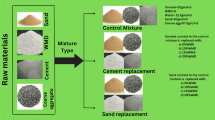Abstract
In last decade, the electrical resistivity of fresh concrete has gained significant attention as a performance criterion due to its practical application and the extent of information it potentially provides on fresh properties. This study focused on the effect of variation of water–cement ratio on fresh electrical resistivity of concrete. In addition, influential factors like dosage of several supplementary cementitious materials (SCMs) namely fly ash, slag, silica fume, metakaolin were considered in combination with pumice material. The results showed that at very beginning, the fresh resistivity pattern moves up to the maximum point before dropping down to the minimum point. It was also found that w/c ratio has remarkable impact on any concrete mixture’s fresh electrical resistivity and this testing was performed by a bulk resistivity meter using three different w/c ratio of 0.4, 0.44 and 0.5. Statistical analysis showed that pumice, Class F fly ash, slag G120S, silica fume, metakaolin mixtures show considerable increment in fresh electrical resistivity at 0.40 w/c ratio and even at 0.50 w/c ratio compared to 100% ordinary portland cement concrete (OPC). Concrete mixtures with different combinations of SCMs behave differently with various proportions and w/c ratio. Some binary and ternary mixtures show little higher standard deviation (SD) values compared to the OPC mixture at different w/c ratios levels due to wide spread of fresh electrical resistivity data. This outcome proves that the mixtures with higher SD value gained lower resistivity during the initial phase and later attained a higher resistivity value. Additionally, initial, and final setting time of concrete have been computed using fresh electrical resistivity data of all concrete mixtures including the OPC. Results indicated 15% to 25% replacement of pumice in binary and ternary mixtures with other SCMs shows wide variation of setting time. In summary, outcome of this research may help construction engineers in the development of affordable field application testing for wide range of pumice based high-performance concrete mixtures and satisfy the requirement of initial and final setting time of concrete.






Similar content being viewed by others
References
Jaiswal SS, Picka JD, Igusa T, Shah SP (2000) Statistical studies of the conductivity of concrete using ASTM C1202-94. Concr Sci Eng 2(6):97–105
Topcu IB, Uygunoglu T, Hocaoglu I (2012) Electrical conductivity of setting cement paste with different mineral admixtures. Constr Build Mater 28(1):414–420. https://doi.org/10.1016/j.conbuildmat.2011.08.068
Torrents J, Roncero J, Gettu R (1998) Utilization of impedance spectroscopy for studying the retarding effect of a superplasticizer on the setting of cement. Cem Concr Res 28(9):325–1333. https://doi.org/10.1016/S0008-8846(98)00110-0
McCarter WJ, MChrisp T, Starrs G, Blewett J (2003) Characterization and monitoring of cement-based systems using intrinsic electrical property measurements. Cem Concr Res 33(2):197–206. https://doi.org/10.1016/S0008-8846(02)00824-4
Snyder KA, Feng X, Keen BD, Mason TO (2003) Estimating the electrical conductivity of cement paste pore solutions from OH−, K+ and Na+ concentrations. Cem Concr Res 33(6):793–798. https://doi.org/10.1016/S0008-8846(02)01068-2
Sant G, Rajabipour F, Weiss J (2008) The influence of temperature on electrical conductivity measurements and maturity predictions in cementitious materials during hydration. Indian Concr J 82(4):7–16
Xiao LZ, Li ZJ, Wei XS (2007) Selection of superplasticizer in concrete mix design by measuring the early electrical resistivities of pastes. Cem Concr Compos 29(5):350–356. https://doi.org/10.1016/j.cemconcomp.2006.12.015
Mancio M, Moore JR, Brooks Z, Monteiro JM, Glaser SD (2010) Instantaneous in-situ determination of water–cement ratio of fresh concrete. ACI Mater J 107(6):586–592. https://doi.org/10.14359/51664045
Obla K, Hong R, Sherman S, Bentz DP, Jones SZ (2017) Relating the electrical resistance of fresh concrete to mixture proportions. Adv Civ Eng Mater 7(1):71–86. https://doi.org/10.1520/ACEM20170126
Sallehi H, Ghods P, Isgor OB (2018) Formation factor of fresh cementitious pastes. Cem Concr Compos. https://doi.org/10.1016/j.cemconcomp.2018.05.011
Tikalsky P, Taylor P, Hanson S, Ghosh P (2011) Development of performance properties of ternary mixtures: laboratory study on concrete. Iowa State University, National Concrete Pavement Technology Center, Ames
Bertolini L, Polder R, Building TNO (1997) Concrete resistivity and reinforcement corrosion rate as a function of temperature and humidity of the environment. Netherlands Organisation for Applied Scientific Research, Delft
Villagrán Zaccardi Y, Garcia JF, Huelamo P, Miao AAD (2009) Influence of temperature and humidity on portland cement mortar resistivity monitored with inner sensors. Mater Corros 60(4):294–299. https://doi.org/10.1002/maco.200805075
Christensen BJ, Coverdale T, Olson R, Ford SJ, Garboczi EJ, Jennings HM, Mason TO (1994) Impedance spectroscopy of hydrating cement based materials: measurement, interpretation, and application. J Am Ceram Soc 77(11):2789–2804. https://doi.org/10.1111/j.1151-2916
Wei X, Li Z (2006) Early hydration process of portland cement paste by electrical measurement. J Mater Civ Eng 18(1):99–105
Zongjin Li, Xiao L, Wei X (2007) Determination of concrete setting time using electrical resistivity measurement. J Mater Civ Eng ASCE 19:423–427
Monteriro PJM, Helene PRL (1994) Designing concrete mixtures for desired mechanical properties and durability. ACI Spec Publ 1994(144):519–543. https://doi.org/10.14359/4406
Li Z, Wei X, Li W (2003) Preliminary interpretation of portland cement hydration process using resistivity measurements. ACI Mater J 100(3):253–257. https://doi.org/10.14359/12627
Acknowledgements
The authors would like to provide their sincere appreciation to CSUF’s research and development office for the intramural grant to support this research.
Author information
Authors and Affiliations
Corresponding author
Ethics declarations
Conflict of interest
The authors declare that they have no conflict of interest.
Additional information
Publisher's Note
Springer Nature remains neutral with regard to jurisdictional claims in published maps and institutional affiliations.
Rights and permissions
About this article
Cite this article
Ghosh, P., Ganesan, R. Effect of w/c ratio on fresh electrical resistivity of various pumice based HPC and computation of setting time. Mater Struct 55, 103 (2022). https://doi.org/10.1617/s11527-022-01939-3
Received:
Accepted:
Published:
DOI: https://doi.org/10.1617/s11527-022-01939-3




